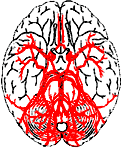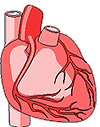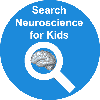 | Transient Ischemic Attacks (TIAs) |
 | Transient Ischemic Attacks (TIAs) |
What is a TIA? TIA is the abbreviation for "transient ischemic attack."
Transient means "passing with time," or "to exist briefly." The term
ischemia, as defined by the American Heart Association, is "a condition in
which blood flow (and thus oxygen) is restricted to a part of the body."
A transient ischemic attack is a brief interruption of the
blood flow to the brain. TIAs occur when a blood clot temporarily blocks
an artery and prevents an area of the brain from receiving the blood and
oxygen it needs. TIAs are short-lived, lasting less than five minutes.
An average TIA usually lasts about a minute. TIAs are often called
"mini-strokes" because they produce stroke-like symptoms. Unlike strokes, TIAs do not appear to cause
permanent damage to the brain. TIA is the abbreviation for "transient ischemic attack."
Transient means "passing with time," or "to exist briefly." The term
ischemia, as defined by the American Heart Association, is "a condition in
which blood flow (and thus oxygen) is restricted to a part of the body."
A transient ischemic attack is a brief interruption of the
blood flow to the brain. TIAs occur when a blood clot temporarily blocks
an artery and prevents an area of the brain from receiving the blood and
oxygen it needs. TIAs are short-lived, lasting less than five minutes.
An average TIA usually lasts about a minute. TIAs are often called
"mini-strokes" because they produce stroke-like symptoms. Unlike strokes, TIAs do not appear to cause
permanent damage to the brain.
What are the symptoms of a TIA?The common symptoms of a TIA are similar to those of a stroke, but are temporary in duration. TIAs can sometimes cause nausea or vomiting. Symptoms occur suddenly and reach their maximum intensity quickly. These symptoms may include:
What causes a TIA? TIAs are caused by blood clots that temporarily block arteries
carrying blood and oxygen to the brain. When an artery is
blocked, blood flow is interrupted and prevented from reaching
parts of the brain. The symptoms a person experiences depend on
the area of the brain affected. After the blood clot is dislodged,
blood flow resumes and the symptoms disappear.
TIAs are caused by blood clots that temporarily block arteries
carrying blood and oxygen to the brain. When an artery is
blocked, blood flow is interrupted and prevented from reaching
parts of the brain. The symptoms a person experiences depend on
the area of the brain affected. After the blood clot is dislodged,
blood flow resumes and the symptoms disappear.If the blood clot is not dislodged or if the brain is deprived of oxygen and nutrients for a long period of time, this problem is no longer considered a TIA, but is now called a stroke. With a stroke, the symptoms are no longer temporary, but are long-lasting or, in some cases, permanent. What to do if a person is having a TIA As with any medical emergency, if you suspect
someone is having a TIA (or a stroke), CALL 911 and GET
MEDICAL HELP IMMEDIATELY. Although the symptoms of a TIA are short-lived,
"TIAs are extremely important predictors of stroke" (AHA, 2003c). The
American Heart Association states that while "most strokes aren't preceded
by TIAs," more than one-third of people who have had one or more
TIAs will have a stroke in the future. In any event, a doctor should be
consulted to determine if a TIA, stroke, or other medical problem with
similar symptoms has occurred and to determine the proper treatment. As with any medical emergency, if you suspect
someone is having a TIA (or a stroke), CALL 911 and GET
MEDICAL HELP IMMEDIATELY. Although the symptoms of a TIA are short-lived,
"TIAs are extremely important predictors of stroke" (AHA, 2003c). The
American Heart Association states that while "most strokes aren't preceded
by TIAs," more than one-third of people who have had one or more
TIAs will have a stroke in the future. In any event, a doctor should be
consulted to determine if a TIA, stroke, or other medical problem with
similar symptoms has occurred and to determine the proper treatment.
How frequently do TIAs occur?According to the American Heart Association (Heart Disease and Stroke Statistics--2003 Update):
Is there a treatment for TIAs?In order to determine the appropriate treatment for TIAs, it is necessary to identify the cause of the TIA. That is why it is important to seek medical help immediately. Treatments may vary depending on the patient's history and current medical situation. Such treatments, which may include drug therapy or surgery, are focused on reducing the risk of stroke in individuals who have experienced a TIA. |
|
References:
|
| GO TO: | Explore the Nervous System | Table of Contents |
![[email]](./gif/menue.gif) Send E-mail |
 Get Newsletter |
 Search Pages |
Page prepared by Erin Hoiland, Neuroscience for Kids Consultant.